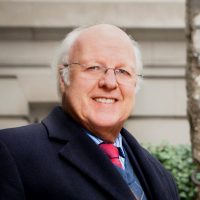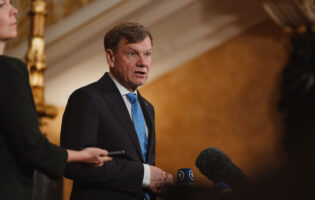The President’s Pitch

Jackson Janes
President Emeritus of AGI
Jackson Janes is the President Emeritus of the American-German Institute at the Johns Hopkins University in Washington, DC, where he has been affiliated since 1989.
Dr. Janes has been engaged in German-American affairs in numerous capacities over many years. He has studied and taught in German universities in Freiburg, Giessen and Tübingen. He was the Director of the German-American Institute in Tübingen (1977-1980) and then directed the European office of The German Marshall Fund of the United States in Bonn (1980-1985). Before joining AICGS, he served as Director of Program Development at the University Center for International Studies at the University of Pittsburgh (1986-1988). He was also Chair of the German Speaking Areas in Europe Program at the Foreign Service Institute in Washington, DC, from 1999-2000 and is Honorary President of the International Association for the Study of German Politics .
Dr. Janes is a member of the Council on Foreign Relations, the International Institute for Strategic Studies, the Atlantic Council of the United States, and American Purpose. He serves on the advisory boards of the Berlin office of the American Jewish Committee, and the Beirat der Zeitschrift für Außen- und Sicherheitspolitik (ZfAS). He serves on the Selection Committee for the Bundeskanzler Fellowships for the Alexander von Humboldt Foundation.
Dr. Janes has lectured throughout Europe and the United States and has published extensively on issues dealing with Germany, German-American relations, and transatlantic affairs. In addition to regular commentary given to European and American news radio, he has appeared on CBS, CNN, C-SPAN, PBS, CBC, and is a frequent commentator on German television. Dr. Janes is listed in Who’s Who in America and Who’s Who in Education.
In 2005, Dr. Janes was awarded the Officer’s Cross of the Order of Merit of the Federal Republic of Germany, Germany’s highest civilian award.
Education:
Ph.D., International Relations, Claremont Graduate School, Claremont, California
M.A., Divinity School, University of Chicago
B.A., Sociology, Colgate University
Expertise:
Transatlantic relations, German-American relations, domestic German politics, German-EU relations, transatlantic affairs.
__
Elected government leaders at any level of government are always expected to give speeches; most enjoy the chance to be on stage. With their speeches, national leaders are given roles as agenda-setters as well as policymakers.
In Germany and in other European parliamentary systems, the chancellor, prime minister, or president carries the responsibility of persuading voters that his or her government is carrying out a successful mandate. These leaders must do so in front of both their supporters and opponents in the parliamentary assemblies they address. As anyone who has witnessed the debates in the House of Commons or in the Bundestag, it can be a very noisy affair.
However, that is not how it works in the U.S. When the president speaks publicly, he does it from the White House or elsewhere around the country, and usually in front of a selected friendly audience. Only rarely–and usually once a year–does the president speak to a combined audience of his supporters and opponents. And with one glaring exception in 2009, the speech is not subject to opposition cat calls as is the case in Europe. That speech happened on Tuesday of this week in Obama’s third State of the Union address.
This time, the speech offered a unique platform to make an argument for his re-election in November. While the interim period will be saturated with television commercials from Obama and from his future opponent, this one evening was a chance for the president to address both the Congress and the nation with a message that will set the tone for his push to win a second term.
Even though it is only one chapter in a long story to be written during the next nine months leading up to the November 6 elections, it offered a window less on the state of the union, and more on the state of the argument about it. That can be of some help for those trying to make sense of what Americans are debating, be it over policy or polemics, and why they are debating the way they have been.
Given that there is an avalanche of conflicting facts and interpretations of those in office, what really emerges from this political cacophony is a mirror of what Americans see–or want to see–in their elected leaders. Despite a continuing decline in trust in government and in those who govern in Washington, voters can become surprisingly motivated in an election year by candidates trying to win or keep a seat in Washington–even as those candidates rail against the city being in gridlock.
The Constitution of the United States demands that the president “shall from time to time give to Congress information of the State of the Union and recommend to their Consideration such measures as he shall judge necessary and expedient” (Art. II, Sec. 3). The exact time for such information and measures to be delivered was not prescribed, nor was an indication on how to present such information provided. Nevertheless, it became a ritual for the president to make the trip down Pennsylvania Avenue to deliver a speech to Congress. Now, the speech is delivered in January and captured on television in the evening when the entire nation can watch the performance. President Obama’s address will continue the tradition that began long ago with George Washington.
In effect, the State of the Union speech is one of the few ceremonial occasions for American democracy. Just as in London when the King or Queen comes to Parliament to deliver his or her speech and must first knock on the door for admittance, so does the president stand in front of the door to the House of Representatives, waiting to be allowed in to address Congress. The kabuki dance that unfolds during the speech, with some standing up to applaud the president while others stay firmly seated, is a demonstration of the political atmosphere in Congress, if not in the country. Members of Congress have the opportunity to be seen demonstrating approval or disdain for the president–be it on television, Youtube, Twitter, or Facebook–creating a circus-like atmosphere.
Obama’s Focus in an Election Year
Anyone expecting a lot in the foreign policy segment would have been disappointed. Like most presidents before him, President Obama spent little time on foreign policy issues, even though he could point out specific accomplishments: killing Bin Laden, declaring the Iraq war over, eliminating terrorists with drone strikes, and backing allied actions that led to Libyan leader Moammar Gadhafi’s ouster and death.
Yet for the majority of voters, these benchmarks will be less commanding. With an economy still weak and millions unemployed and fearful about their futures, the focus of his message was on domestic issues. Even though Obama inherited an unholy mess in 2008, he has been captain on the bridge since January of 2009 and he needs to present a course for the future. This course should be based on what he can say he has accomplished, and more importantly, what goals are still out there to be realized. Most of those goals are going to be shaped by long-term challenges: unemployment, social security, health care reform, and immigration. With Congress seeing historic lows in public support, and the president’s rankings somewhat higher, Obama underscored what needs to be done and urged Congress to overcome its gridlock.
Such a State of the Union speech in an election year becomes particularly important for a first term president seeking re-election. The need to underline accomplishments, as well as the reasons why the president would like four more years, becomes a challenging balancing act. There needs to be a case made which does not focus too much on his opponents in the room–in Obama’s case, the Republicans–but rather implores the entire Congress to work toward achieving outstanding goals. Since the Democrats control the Senate, he cannot be overly critical of Congress, while still trying to insinuate that Congress has been unable to generate a consensus to move the country forward. The president cannot easily argue, particularly in Obama’s case, that without his leadership, things would have been worse. You don’t win elections with a negative message.
Building a Case for Re-election
Of course, most believe that not much will happen for the rest of 2012. The race for the White House and control of Congress will suck most of the energy out of the air when it comes to compromise and consensus building. The president knows that and will make his pitch to the national audience that elected him in 2008. He understands the groundswells against him but he also knows that, apart from having to mobilize his supporters, there is a small sliver of voters, mostly independents, who can make the difference on November 6.
Although most of these speeches become quickly forgotten, they usually present familiar challenges and choices when it comes to the domestic situation a president faces. Most presidents have tried to underscore how their time in office has led to breakthroughs and progress, at home and abroad. Obama certainly followed that path.
There are ways the State of the Union speech can leave a mark on the race this year if it can capture a link between how Obama appears as a leader and how voters, currently despondent and distrustful of government in general, identify with his message. Yet, the challenge is that voters are so fractured and segmented in their concerns, highlighted at the moment on the one side by the Republican Party’s battle for a candidate to oppose Obama. On the other side, the president is confronting a decline in synergy among those groups which assembled Obama’s support four years ago, be they unions, younger voters, or various other single interest groups disappointed that the president did not meet their various expectations.
For many watching from outside the United States, the theatrics of a presidential election year, including the enormous amount of money floating through it, may seem to be a demonstration of the worst of American politics, made up of mudslinging accusations short on truth and long on innuendos, if not outright false claims. As one astute political observer puts it: every two years the American politics industry fills the airwaves with the most virulent, scurrilous, wall-to-wall character assassination of nearly every political practitioner in the country–and then declares itself puzzled that America has lost trust in its politicians.
The effort to mobilize over 220 million potential voters never succeeds, with only somewhat over half eventually casting their vote. Finding the right messages to appeal to that many Americans is an enormous challenge for any candidate. For this reason, most try to aim their pitch at the most likely supporters and hope that other voters will swing his or her way. Given the current polarized atmosphere, the election this year will be likely won by a very narrow margin.
This year, a large set of primaries offer a chance to determine who the Republican candidate will be to challenge Obama and the messages he will take to the final race in November. An incumbent president seeking a second term has to base his message on his record. This is what President Obama will needed to do in the State of the Union speech and what he needs to do over the next nine months, while still emphasizing what remains to be done in the next four years.
By the time the November election day arrives, Obama’s State of the Union address may well have been overtaken by events, at home or abroad. Whether there is a catchy phrase remaining from the speech is questionable.
Nevertheless, it is probably worthwhile listening to the speech not only as a benchmark for the Obama campaign strategy, but also to evaluate one of the competing visions being offered for the future. Many of these State of the Union speeches, when placed next to each other, sound very similar with the same rhetoric, whether delivered by a Republican or a Democrat. President Obama would do well to study the speeches given by the three one-term presidents during the past forty years–Ford, Carter, and Bush (senior)–and perhaps to compare them with those given by Presidents Reagan, Clinton, and Bush (junior) to see what they said in the year of their respective defeats or re-elections. Furthermore, the relatively recent tradition of having an immediate rebuttal to the president’s speech offered by the opposing party will add more to the picture of the debate in coming months.
Obama had already set the themes of his State of the Union speech with an earlier address given last month in Kansas. Speaking on the 100th anniversary of a speech by one of his presidential predecessors, Teddy Roosevelt in 1911, Obama previewed his emphasis on the economy and jobs, but also on a theme that will be a red line through his campaign this year: fairness for the middle class.
The past year has seen Republican charges leveled at the president for engaging in what is labeled class warfare, meaning his criticism of those with high incomes and his suggestion to levy higher taxes on the rich. Given the reality of serious problems for millions of Americans in a fragile economy, the debate over how to offer them a way out and up will be at the center of this year’s election campaigns.
Fleeting as they may be in an election year, these speeches are evidence and testimony to a long-standing debate in the United States about what the national interests and aspirations are or should be. Obama’s speech is just one more in a long line of such arguments. But at a time and in an atmosphere when it is increasingly difficult to forge common ground within and across political lines, when the citizens’ expectations for institutions of government, the media, and political leaders are at best cautious and at worst skeptical, an effort to capture the essence of the current argument remains important. Because we are in danger of losing the capacity to act collectively to deal with problems that need a combined response, an appeal to remind us of that need remains critical. In the United States, the president’s job is to articulate that appeal, as difficult as it is to implement. Once a year, the president gets the moment to do just that in a joint session of Congress for the State of the Union address. It is at this moment when everyone is supposed to be listening not only on Capitol Hill, but around the country.
The moment only lasts about an hour. But it is a demonstration of what the president’s unique role is or can be about.








